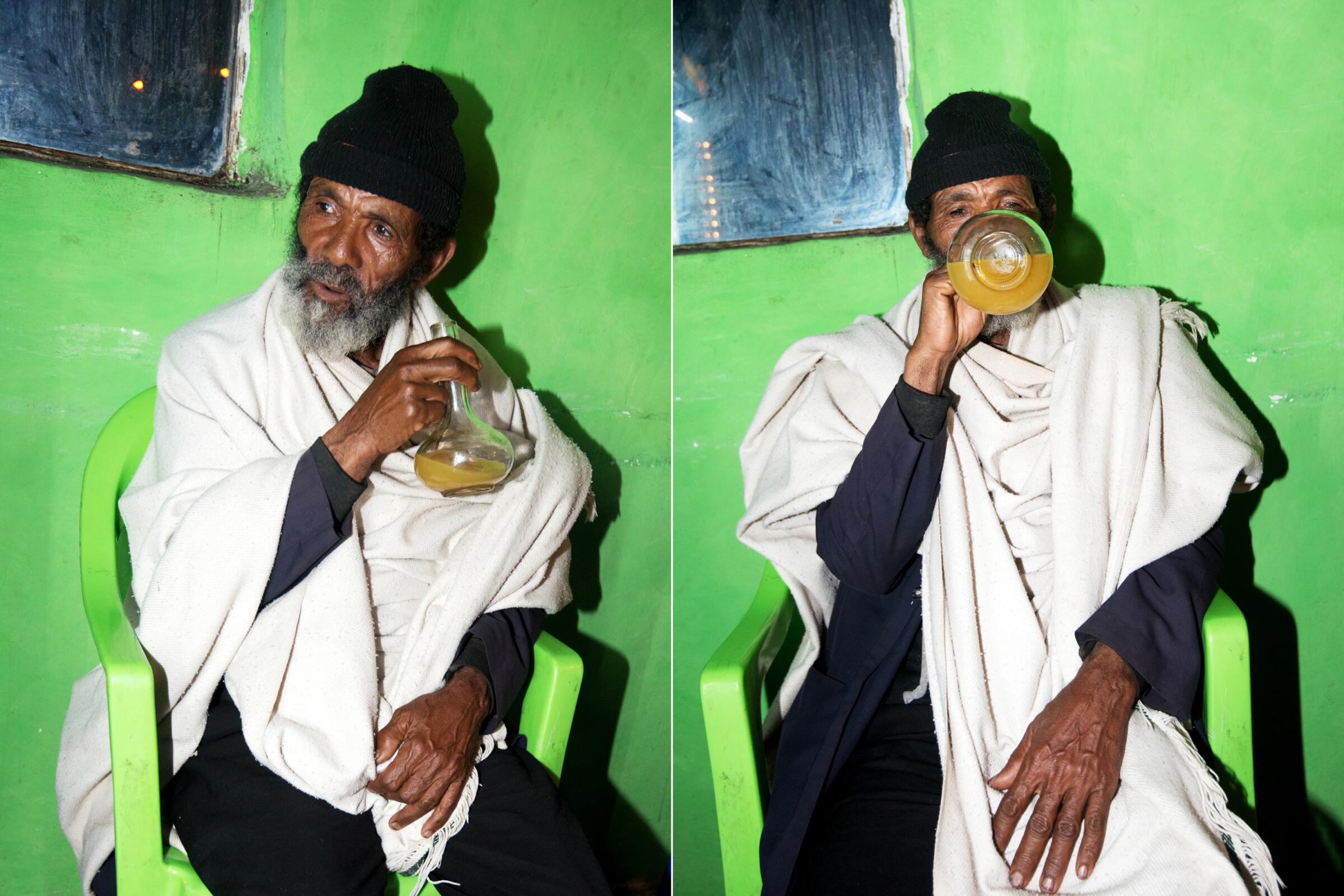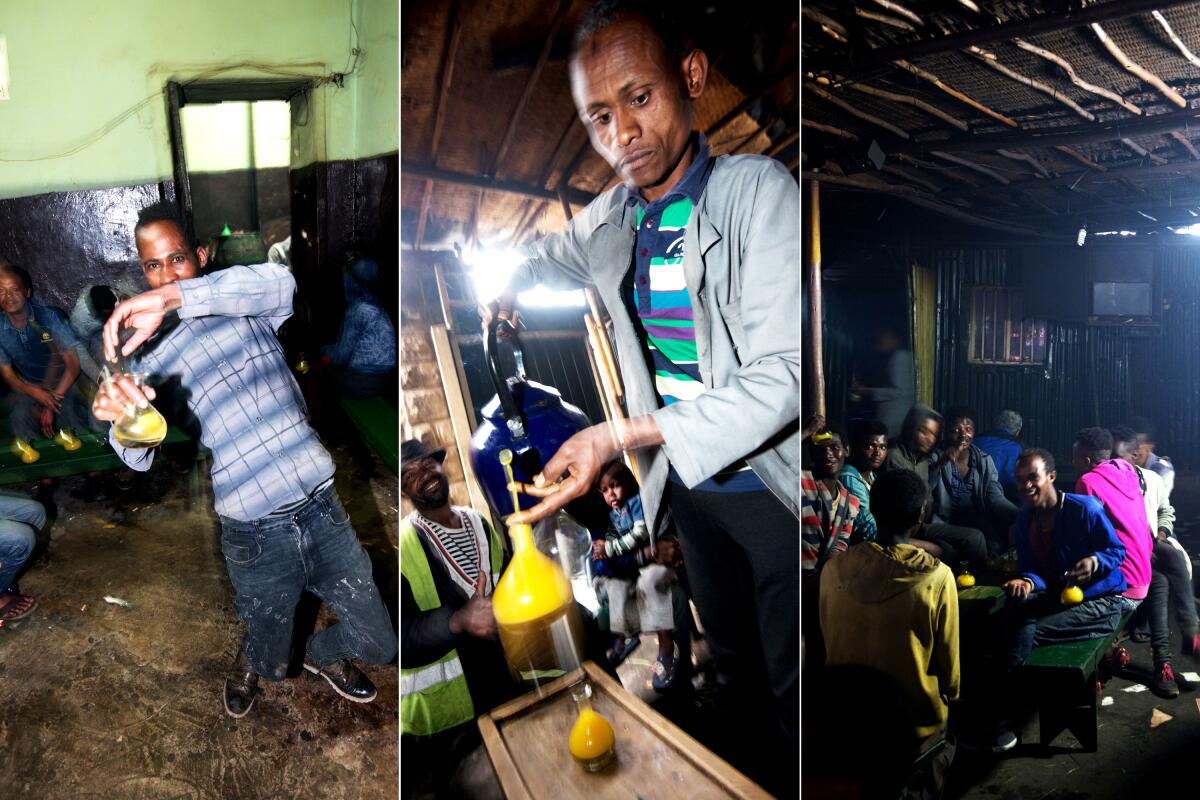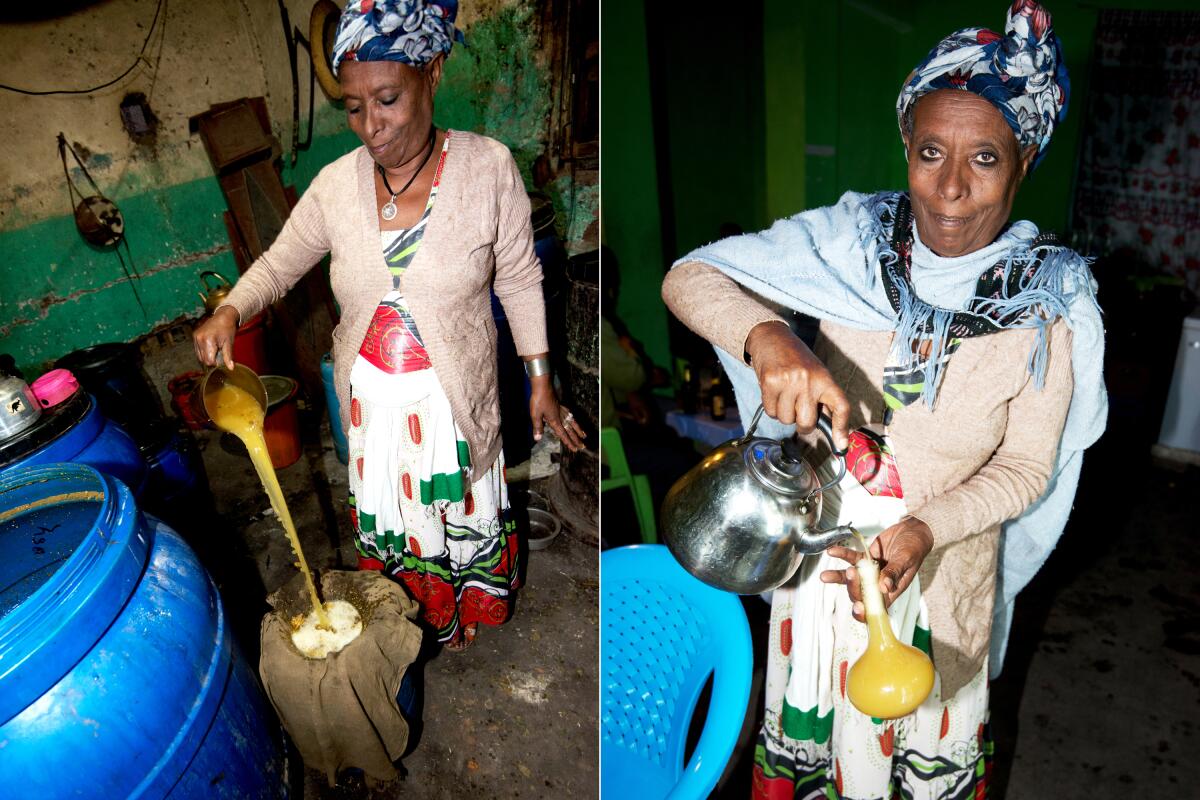Newsletter
Eat your way across L.A.
Get our weekly Tasting Notes newsletter for reviews, news and more.
You may occasionally receive promotional content from the Los Angeles Times.

ADDIS ABABA, Ethiopia — We were run out of the first bar. Ethiopians, my fixer and translator Birhanu told me, don’t like being photographed. During the famine of the ‘80s, he explained, international reporters descended on Ethiopia and took photos and video — “took” being the operative word here — that Ethiopians felt didn’t depict their country or people in a positive way. Since then, there has been a general wariness about being in front of the lens.
This made things tough: I was in Addis Ababa, the capital of Ethiopia, to write and photograph a piece on tej bet, rustic bars where men — and almost exclusively men — drink honey wine. And the tej bet that Birhanu had taken me to was, frankly, photography gold.
Ascending a cobblestone street in the city’s ancient, frenetic Piassa district, we ducked into an unmarked door on a cobalt-colored building and emerged into several linked, dark, smoky, cacophonous rooms, the walls painted green, the perimeter lined with low benches that were absolutely packed with dudes. At knee level, along a low table, were small, beaker-shaped glasses of orange liquid — the eponymous tej. I was shaking with excitement and trepidation.

A server arrived, and from an immense teakettle poured streams of tej into our beakers. Made from fermented honey and given a slightly tannic hit with the addition of a leaf known locally as gesho, tej looks and tastes like orange juice. It generally contains around 6% alcohol, but one barely tastes it, and it’s possible to slam several beakers before it hits you all at once.
As a white guy with a notepad and a huge camera bag, I couldn’t have stood out more in the tej bet, and I sought to ease the tension by clinking glasses with those around me. I fell into conversation with Wasyehune, a 23-year-old painter whose youth and sober state made him stand out almost as much as I did. I asked him why he opted to drink tej rather than beer or whiskey. “To feel the real essence of the people,” he said, rather grandly, in English. “It’s not just about putting alcohol in your stomach. It’s about socializing. It’s what our fathers did. We are drinking history!”
While we spoke, a child vendor squeezed by hawking samosas from a vast bowl. A man rattled a tin can filled with numbered chips: a lottery. A vendor sold boiled nuts served on scraps of recycled paper. The server continued to make his rounds, pouring from the teakettle without spilling a drop while mentally cataloguing how many beakers had been served — an utterly astounding feat given the number of drinkers and the chaos. A woman — the only one there — took Birhanu aside and told him to be careful: This is where pickpockets come to drink.
Yohannes, another drinker, approached us. “It’s a traditional drink; Ethiopian kings drank honey wine,” he said before adding, rather pragmatically, “And it’s cheap; one glass costs 5 birr (about 17 cents).”
Two beakers in, feeling the buzz and succumbing to a very strong desire to record the scene, I pulled out my camera. Almost immediately, men were shaking their heads disapprovingly and asking Birhanu if we had been given permission to photograph in the tej bet (we had). At the same time, some of the more drunk men asked me to take their photos. I crossed the room to do this, and those in the periphery of the photos ran to Birhanu to angrily request compensation. Sensing that I’d sparked something that could take an unpleasant turn, I tried to make it back to my seat but a man grabbed me and, slurring in Amharic, hugged me and kissed my cheeks. We had officially reached that minuscule window of sloppy, inebriated conviviality that can quickly and inexplicably turn to belligerence. Birhanu was palpably anxious, and pressing small bills into open palms, indicated to me that we needed to leave. Now.
We hit one more venue that evening with similar results (“Be cool, man,” said the last drinker I encountered, as he held my notebook hostage), so I took a break from tej bet until I’d reached the small rural town of Lalibela, in northern Ethiopia. The town is known to the outside world for its ancient churches, carved out of stone. But among Ethiopians it might be just as famous for its traditional tej bet. This is, allegedly, because King Lalibela (1185-1225), the town’s namesake, is said to have had an intimate history with the producers of tej’s main ingredient: As a child, he was found sleeping in a cave full of bees, but aware of his inherent and impending royalty, they opted not to sting him.
With the help of Memekia, another guide and a native of the town, I was taken to Berkay Tej Bet, a relatively modern structure, painted pink, on a hill overlooking Lalibela. As is usually the case with tej bet, Berkay, the eponymous owner, made her own tej in-house, and was kind enough to show me how this was done.
“I’ve been making tej for 30 years,” she said, standing beside a plastic barrel of fermenting honey wine. “I learned from older people, working for free. Then later, I opened my own place.”

She pulled out a bucket of “red” honey — thick with wax, dark in color and more earthy and rich in flavor than sweet — and explained that she combines it with water, seals the mixture in plastic barrels, and leaves it for a month. At this point, the mix is only slightly fermented, and she adds the gesho, known in English as shiny-leaf buckthorn, which she claimed both gives the mix a tart flavor and kicks the fermentation into overdrive. After another month, the tej is sufficiently boozy and is strained into the ubiquitous teakettles.
I expressed surprise that a woman was behind what appears to be such a male-centric world, and Berkay told me, “In Lalibela, all tej bet are owned by women. In our culture, men don’t make tej.”
We headed upstairs to the bar, and Berkay’s tej bet couldn’t have been more different from its counterparts in Addis Ababa. The cement hall felt cozy, like a large living room, with drinkers lounging in plastic chairs. Memekia told me he recognized some of the customers as local teachers and officials, and the only sound was the low-level buzz of conversation.
“Nobody fights in here,” Berkay told me. “We only have music on special holidays. We hope to encourage discussion.”
I ordered a beaker, and Berkay’s tej was balanced if unremarkable, equal parts tart and sweet, with a hit of funk and a pale orange color. I raised my beaker to Getu, a Christian Orthodox priest sitting nearby.
“When I was young, I would go out with the senior priests, and they would give me a taste of tej,” Getu told me, when I asked how long he’d been drinking the stuff. I asked him if women were allowed to frequent tej bet, and he became stern and said, “If I saw a woman drinking here, I’d pass along the information that she would not make a good wife.”
Memekia and I finished our beakers and crossed town to Mar Talo Tej Bet. The bar had a traditional wooden roof, a dirt floor, walls decorated with local bric-a-brac, and an owner with a reputation for buying only the highest-quality honey. Memekia told me this tej bet is one of the more famous. And it took only a sip to see why: Mar Talo’s tej was vibrant and slightly effervescent, with an appealing bright orange color.
“This is the best tej bet in the country,” said Zenaw, an itinerant government auditor sitting nearby. “I come here every time I’m in Lalibela.” I asked what was special about tej, and he replied, “If I don’t drink it, then who will? Other people are being brainwashed by beer companies.”
We continued to chat in English until, suddenly, the power went out, a frustratingly frequent occurrence in Ethiopia. With the fluorescent lights extinguished and the TV no longer flashing the Amharic-language channel from Washington, D.C., the interior lit by a single candle, the walls washed with a warm glow that matched the content of our beakers, I took my last sip of the night and finally, I think, began to understand what a tej bet was supposed to be.
Eat your way across L.A.
Get our weekly Tasting Notes newsletter for reviews, news and more.
You may occasionally receive promotional content from the Los Angeles Times.